-

2020-05-09
This story is about my partner's family, utilizing both of our perspectives to talk about how his mother, and subsequently my partner, was treated due to mental illness, ethnicity, and gender identity.
-
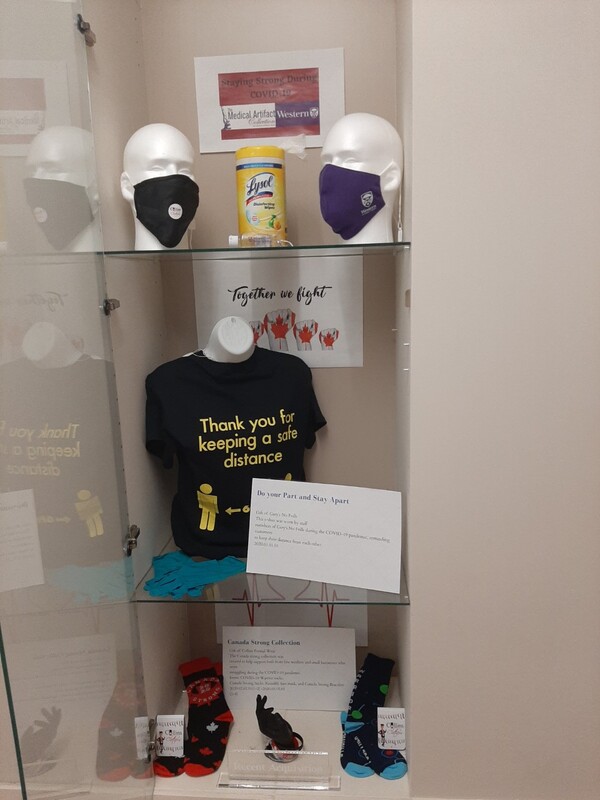
2020-09-30
This exhibit was installed by the Medical Artifact Collection at Western University. It features several COVID-19 related artifacts that were recently donated to the collection in 2020. The exhibit was curated and installed by the collection's research assistant Kat Bezaire.
-
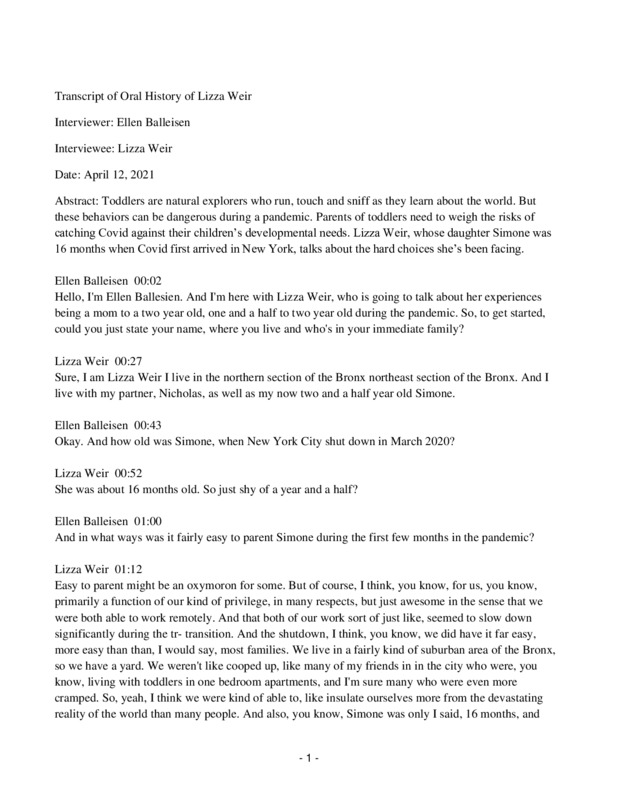
2021-04-12
Toddlers are natural explorers who run, touch and sniff as they learn about the world. But these behaviors can be dangerous during a pandemic. Parents of toddlers need to weigh the risks of catching Covid against their children’s developmental needs. Lizza Weir, whose daughter Simone was 16 months when Covid first arrived in New York, talks about the hard choices she’s been facing.
-
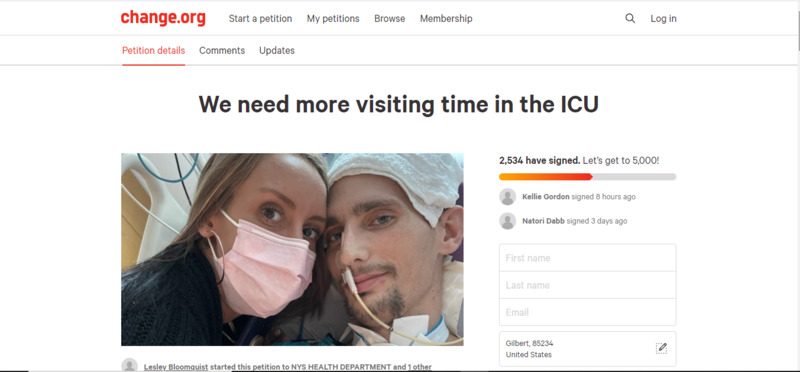
2021-05-03
I’m in a mom group on Facebook where this was shared. The woman who began the petition outlines her struggle with her husband’s traumatic workplace injury and how their lives and his recovery is impacted by the ICU’s COVID rules. There are also many comments by petition signers who believe COVID restrictions do more harm than good.
-
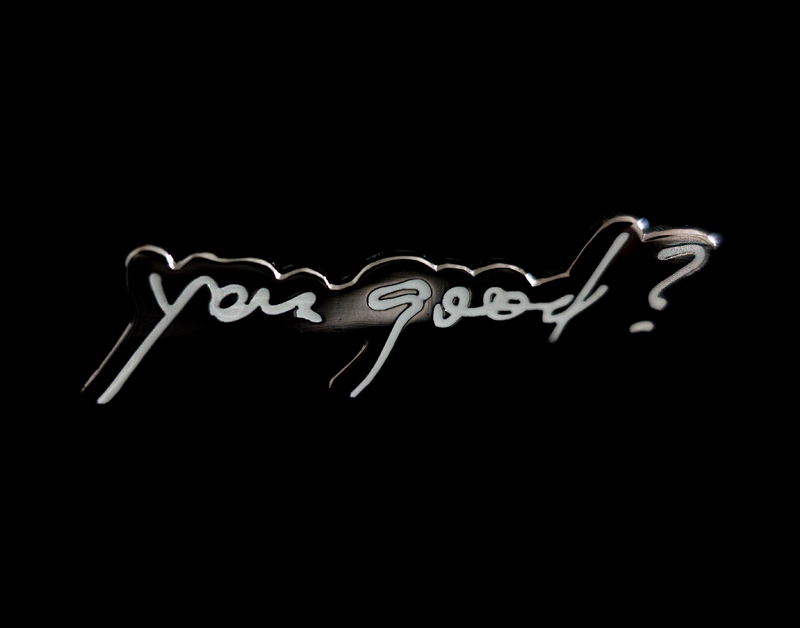
2021-01-22
At the beginning of the shut down, I got an email from a friend who asked "you good?". I didn't know how to answer that; I wondered if anyone was "good". Over the next few months I worked on a photographic piece for a show at the Museum of Art and History in Lancaster that opened in January. I had a neon sign made for the title. The museum then had glowin the dark pins made to sell in their store. It seemed to hit a nerve because it sold out in few weeks and they have to reorder. I have a fantasy of everyone walking around with these pins: you good?
-

2021-04-30
Prom has been cancelled across the United States. While this is the case for most places, select locations are finding ways to make prom possible. For a school district in Pennsylvania, this meant having prom on the football field. This allowed them to enforce social distancing while still allowing the students to play games and have fun.
-
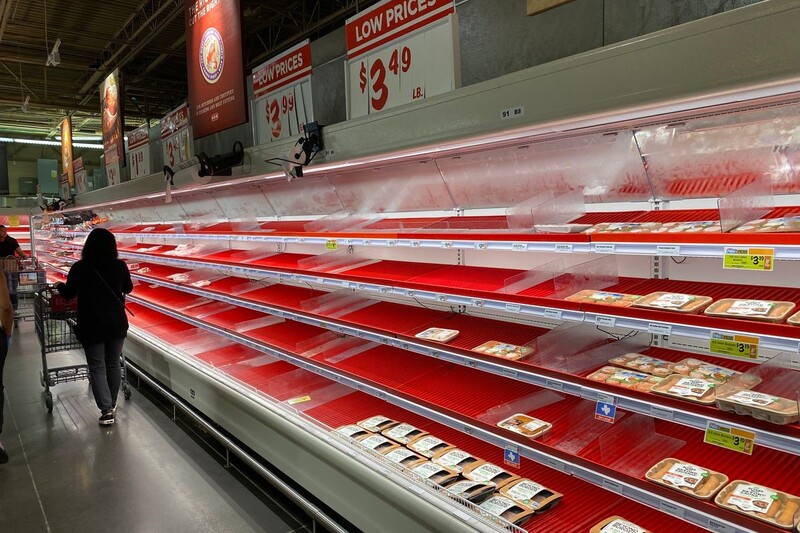
2020-03-06
When the pandemic first started people were out of control buying food and house supplies. There was a shortage on meat and the price rose up to an unreasonable price. Not only that the people were buying all the toilet paper. Like whom would have thought we will run out of toilet paper.
-
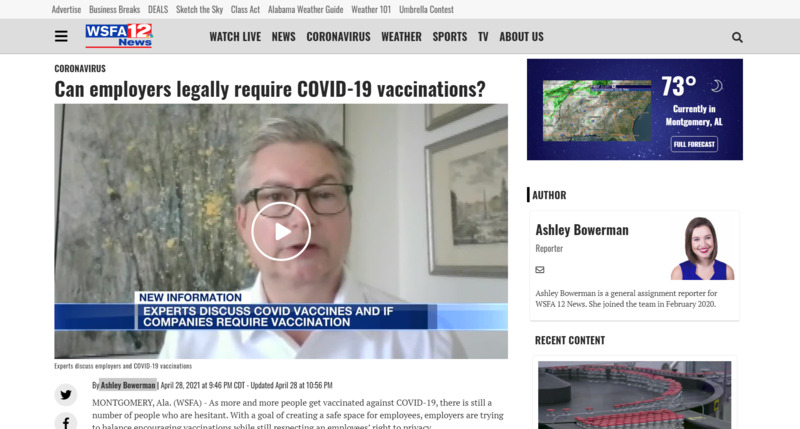
2021-04-28
As the COVID-19 vaccine becomes available to everyone, there are questions about whether or not an employer can require employees to get the vaccine. While making the vaccine required is well within the rights of an employer, it is unlikely this will happen. However, there are many places that are strongly recommending that employees get the vaccine.
-
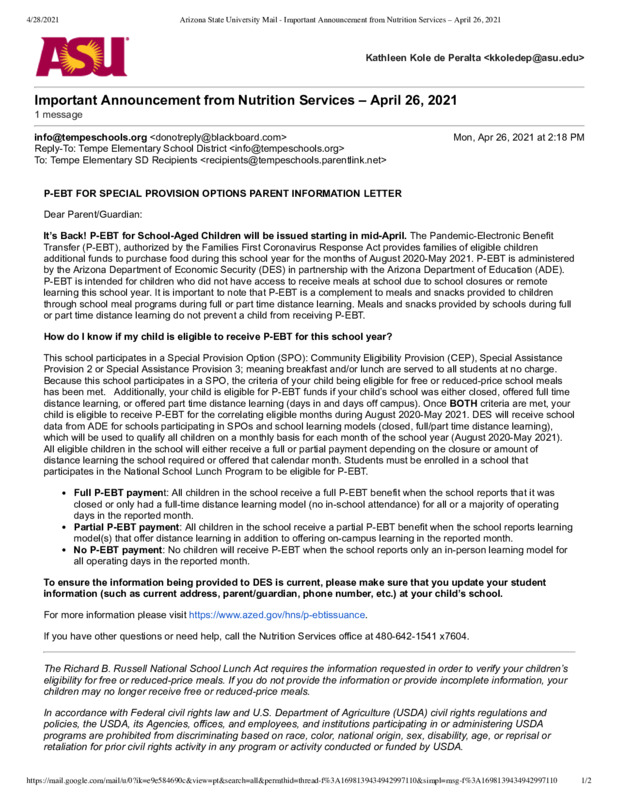
2021-04-26
One unexpected surprise during the pandemic was that everyone enrolled at my daughter's school received the pandemic-electronic benefit transfer. Essentially, because kids were at home learning online, they did not receive breakfast or lunch at school. There were pickup options, but we didn't really use that service. So, instead, the state mailed us a card that can be used to buy groceries. It was really unexpected, and we just found out that we get another allowance this week. It's a really nice boost to the grocery budget and it recognizes the importance of nutritious, consistent meals for kids.
-

2020-04-18
At the beginning of quarantine, people were planning surprise personal birthday parades filled with cars of people honking, holding posters, or even throwing confetti. I believe that this was one of the moments that showed communities coming together, and it is really awesome to see this good news. I am very grateful that my family and friends helped me celebrate my birthday safely like this!
-
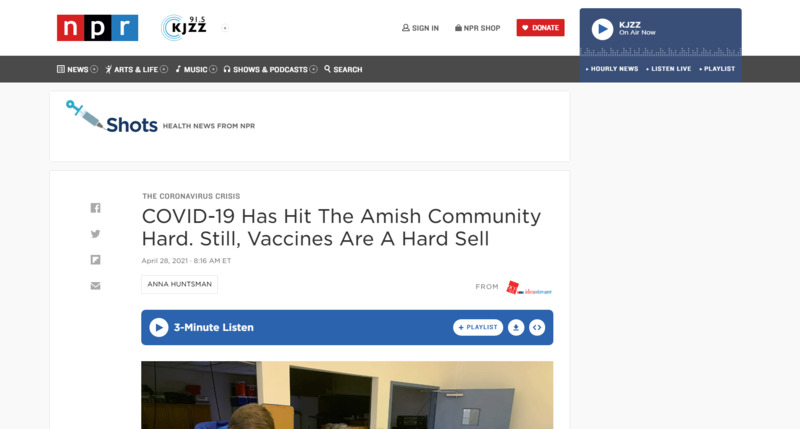
2021-04-28
Officials are having a hard time convincing Amish populations to get the COVID-19 vaccine. This has been attributed to cultural differences and it's believed they'll start getting the vaccine once it's been around for some time. In the meantime, there are fears that the communities will have more COVID-19 outbreaks.
-
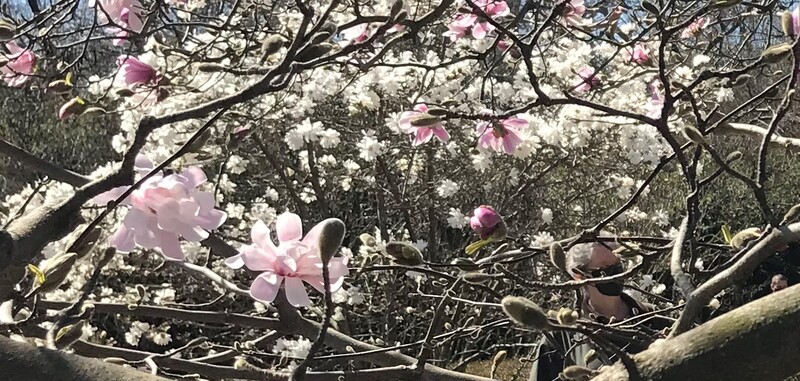
2021-04
Ever since the pandemic started, I’ve been spending a lot of time outdoors in parks and public gardens. While outdoors, I often take photographs. Recently I was looking through my photos and noticed that many of the ones taken in March and April 2021 showed masked faces through foliage. Somehow this seemed like a good way to remember Spring 2021.
-
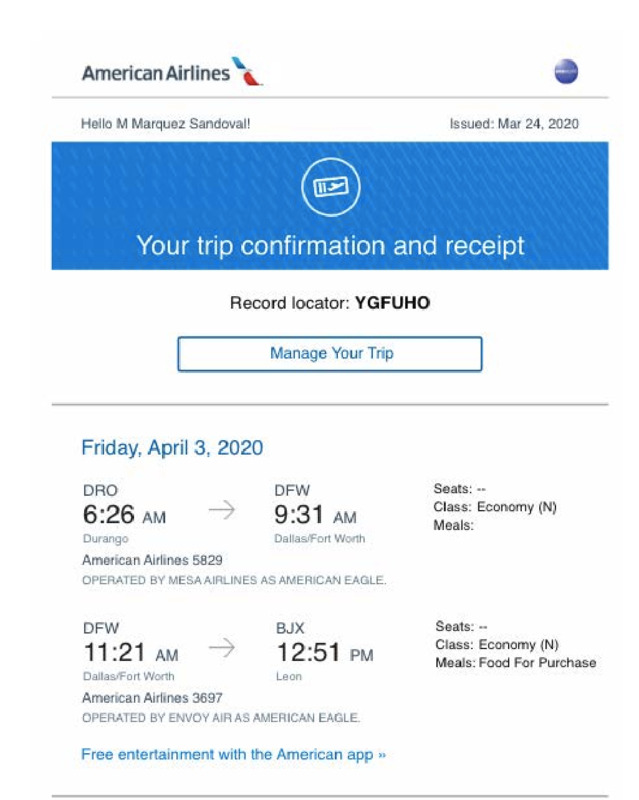
2020-04-08
In March 2020, when the COVID-19 pandemic arrived in the USA I was a history teacher at Fort Lewis College in Durango, Colorado. When the stay-at-home order was issued by Colorado's government and FLC confirmed classes online only I was eager to come back to my home country, Mexico. After my boss's approval, I proceed to purchase my flight ticket. Prices were constantly changing even on the same day. One ticket could go from over $600 around 8 am, to $450 at noon and less than $300 by the afternoon. Other days ticket were more expensive in the morning and less by the evening. I originally purchased my ticket for the end of April but when rumors of a potential USA's close of borders increased, I changed my ticket for April 3 to prevent more stress about the potential risk of being stranded at Durango's or Dallas's airport. I profited from the no-cost policy to change plane tickets and went ahead. The mood at both airports was eerie with very few travelers. Even the usually overcrowded Dallas Airport looked empty. Passengers at waiting rooms were scarce and food vendors were hard to find as most of them were closed. The few open had blocked their seating sections. To find my boarding room was very hard as it was constantly changing within few minutes. To board my international American Airlines Flight 3697 from Dallas to Guanajuato, Mexico, I walked from one side to another and took the train to another terminal. By the time I had arrived it was already changed again. Surprisingly my American Airlines Flight 3697 had plenty of passengers. I could not identify a single non-Latino traveler. It seems that most passengers were Mexican nationals or descendants. I paid a small difference to be upgraded to First Class and I was very pleased that few passengers chose that class. Nobody sat beside me or in the other section after the corridor. However, as previously announced and confirmed at boarding, no meals or beverages were going to be supplied at all during the flight. Boarding had no problems, although I noticed there were no police officers at boarding, as usually happens on flights to Mexico, nor a double safety search was made. The flight went smoothly and once I arrived on time at Guanajuato International Airport I noticed that a lot of passengers were not wearing masks, and they were not mandatory at the flight nor at the airport. I had mine. Once we passed Mexican' Customs, passengers were told to do two lines for Mexican and Non-Mexican travelers to pass a health inspection. We had to fill out a questionnaire about our activities of past days and if we had any fever or cold-related symptoms or if we had contact with someone sick. Depending on your answers you were put in a different room, but for me, that answered negatively all questions, I met with a nurse who scanned my temperature on my forehead and requested my address, email, and phone number. I was strongly recommended to self-quarantine at home for at least 14 days, which I did. My husband was waiting for me at the airport and regardless of what we were doing in the USA, I did hug him and saw other passengers did as well with their families picking them up at the airport. For some moments COVID policies did not apply to our beloved ones!
-
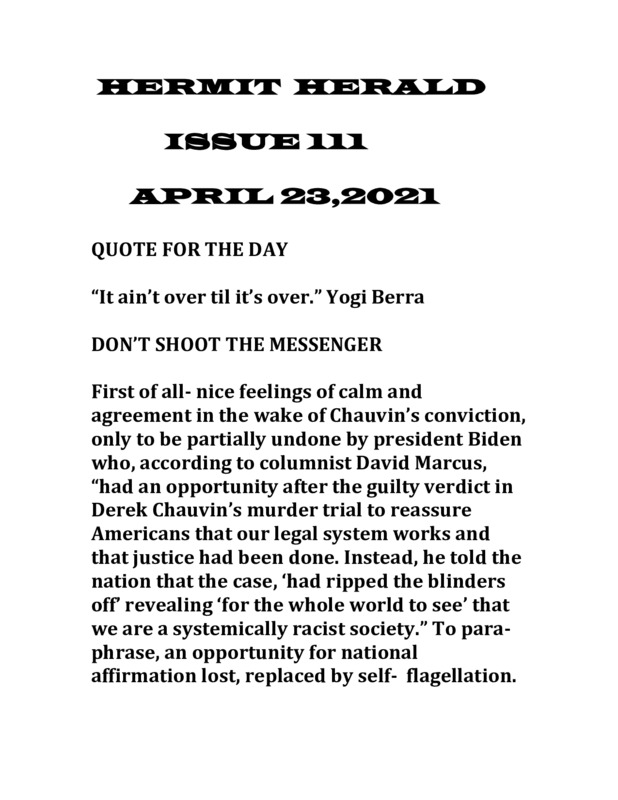
2021-04-23
Chauvin appeal
-

2021-04-26
[1] This copyright-free image, courtesy of pexels.com, shows Corporal S. Brantley from the Wheeling (West Virginia) Police Department monitoring a protest.
[2] This copyright-free image, courtesy of pexels.com, shows officers from the New York City Police Department, some of whom wear COVID face masks, beneath scaffolding on a sidewalk.
-

2020-03-29
I struggled with anxiety around the time the news said there was a pandemic going on, and I healed as time went on and the world around me played a part in that.
-
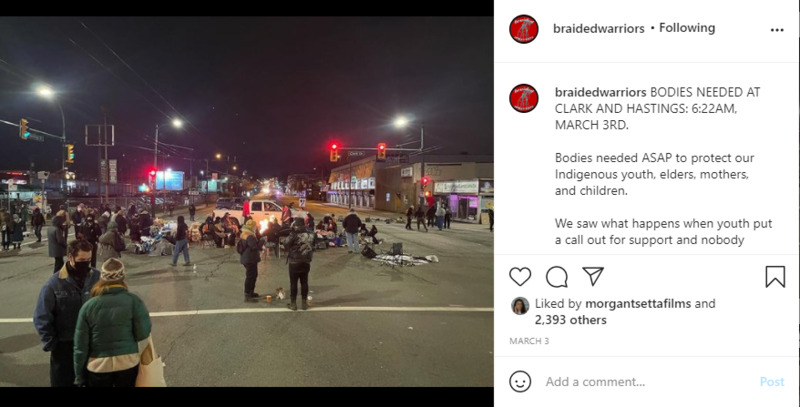
2021-03-03
This is an image of a protest blockade in support of a jailed Indigenous elder, who was arrested for protesting at the Trans Mountain pipeline construction sites in Burnaby, BC. The elder, Stacy Gallagher was arrested while preforming a smudging ceremony. This blockade was organized by the Braided Warriors, calls on their social media platforms brought more bodies to help maintain the barracade against the agents of the Canadian state and the Crown.
The post's description stated,
"BODIES NEEDED AT CLARK AND HASTINGS: 6:22AM, MARCH 3RD.
Bodies needed ASAP to protect our Indigenous youth, elders, mothers, and children.
We saw what happens when youth put a call out for support and nobody showed up - Indigenous youth, mothers, and elders were violently attacked - left with concussions and lasting injuries we are still recovering from. Numbers are low and early morning is typically when police move in. People have been holding it down here all night, and need bodies down here immediately.
When our numbers dwindle, we are in danger.
The Crown will not hesitate to criminalize Indigenous peoples.
Your inaction is complacency, and complacency is violence.
Put your body on the line.
PROTECT OUR INDIGENOUS CHILDREN, YOUTH, MOTHERS, AND ELDERS. PROTECT THE SACRED FIRE."
The comments of this post have messages of solidarity, people organizing for food and water, and those stating they would be arriving on the scene to help.
-
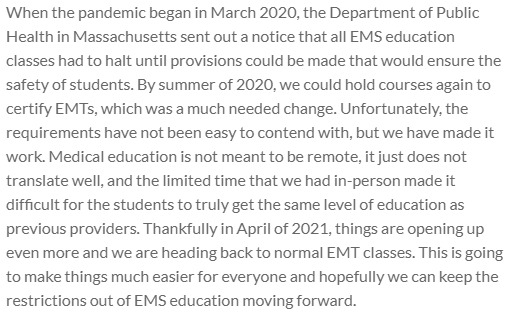
2021-04-25
When the pandemic began in March 2020, the Department of Public Health in Massachusetts sent out a notice that all EMS education classes had to halt until provisions could be made that would ensure the safety of students. By summer of 2020, we could hold courses again to certify EMTs, which was a much needed change. Unfortunately, the requirements have not been easy to contend with, but we have made it work. Medical education is not meant to be remote, it just does not translate well, and the limited time that we had in-person made it difficult for the students to truly get the same level of education as previous providers. Thankfully in April of 2021, things are opening up even more and we are heading back to normal EMT classes. This is going to make things much easier for everyone and hopefully we can keep the restrictions out of EMS education moving forward.
-
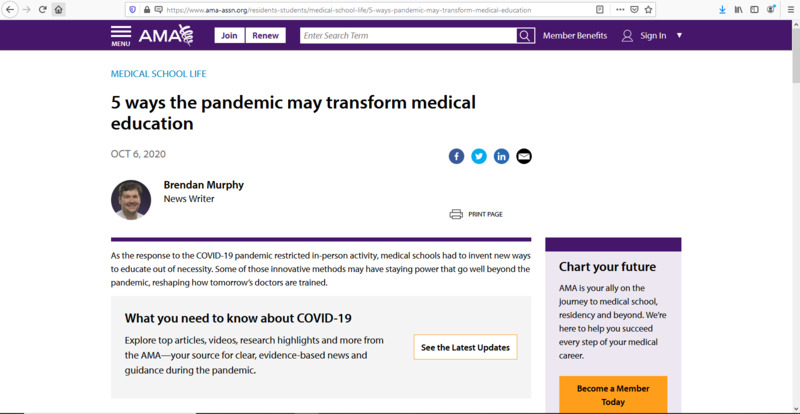
2020-10-06
Medical schools have had to come up with unique ways to continue to educate future physicians during the lockdowns and pandemic restrictions. This has not been an easy process, and it remains to be seen the long term effect of those who had to go through medical school during the pandemic. However, there will certainly be long-lasting changes to the ways in which we educate medical school students forever after. This article lists 5 ways in which medical school education will be impacted by the Covid-19 pandemic. They are an emphasis on public health, real-time curriculum adaptation, potential to reevaluate graduation requirements, changes in residency selection, and new approach to crisis management. It will be interesting to see how these things impact the quality of physicians down the road.
-
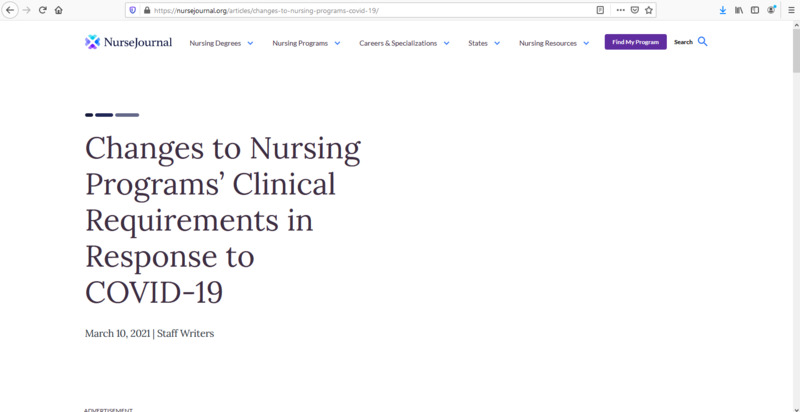
2021-03-10
Covid-19 and the pandemic has had a significant impact on the healthcare industry. Healthcare providers that were nearing retirment had a good reason to retire early, and many others that felt the job became too dangerous or mentally taxing left the medical field forever due to Covid-19. The numbers of nurses have suffered as a result, and that means that during the worst healthcare crisis in recent history, the nurses that were working had even more burden placed on them by staffing problems. This article explains the ways in which nursing schools have responded to try and get more people into the field.
-
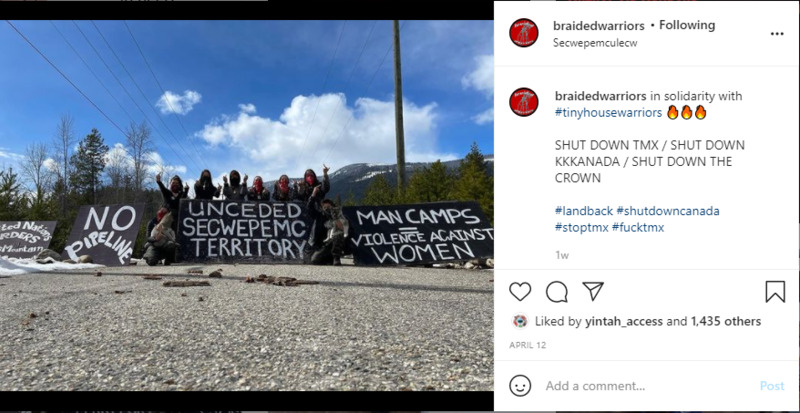
2021-04-12
An image of land defenders and their blockade on Secwepemc territory. These land defenders are calling for a cessation of the construction on the Trans Mountain Pipeline, which runs through unceded Secwepemculecw and Wet'suwet'en territories. While these piplines represent a threat to the ecology of the region, the construction represents the continuation of Canada's colonial reality into the years of pandemic. Furthermore, the construction of this pipeline has resulted in the creation of several work camps for transient labourers which have been called 'man camps.' These camps have been identified as a threat to indigenous communities, with particular threat of violence against First Nations women in the areas surrounding these camps, they have also been linked to the perpetuation of one of Canada's greatest crimes, MMIW (Missing and Murdered Indigenous Women). As identified by the supplementary report on the Missing and Murdered Indigenous Women in 2019, the perpetuation of this crisis and the lack of action on behalf of the Canadian state is a genocide, according to the U.N.'s definition of genocide. In truth, it is continuation of the genocidal campaigns against First Nations peoples across North America, the pursuit and extraction of capital by exploiting the land and the peoples who walked upon it first. These Tiny House Warriors in the comments call for land back, and a general campaign to shut down Canada. As of now, construction on the TMX continues unabated, the government of Canada shows no sign of upholding the call to Truth and Reconciliation.
-
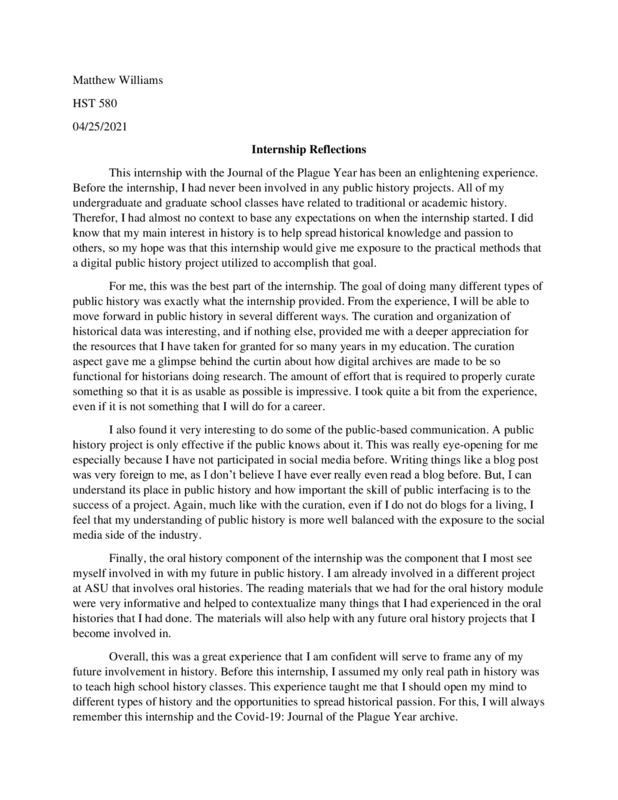
2021-04-25
This is the end results from my experiences as an intern with the Journal of the Plague Year archive
-
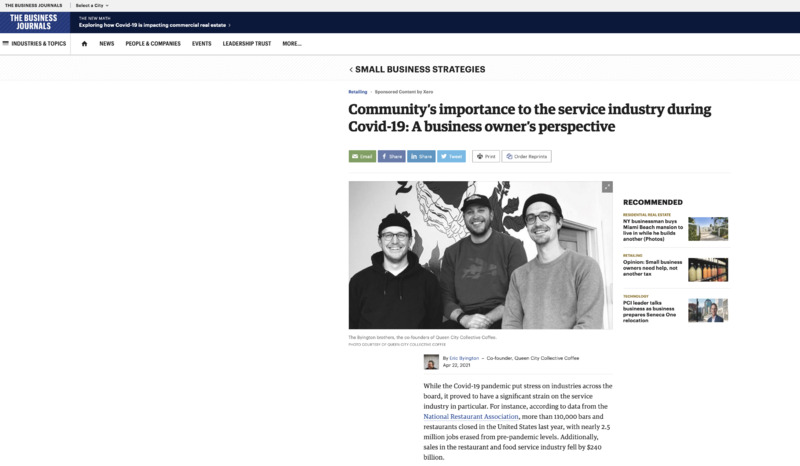
2021-04-22
This article, written by small business owners, addresses the challenges faced by the service industry during COVID-19. These owners of a coffee shop share a list of ways that the community can support their local service industry, and why it is crucial to do so. They make it clear that it's not simply about buying a product; instead, it is about building a community and supporting those that you care about, which goes both ways. If you support small business owners and show that you're there for them, they in turn will give back to the community in any way that they can, creating a caring environment. The lessons they share are so important to keep in mind as we are still dealing with the pandemic, so that we can build a support system that lasts long past when the pandemic is over.
-
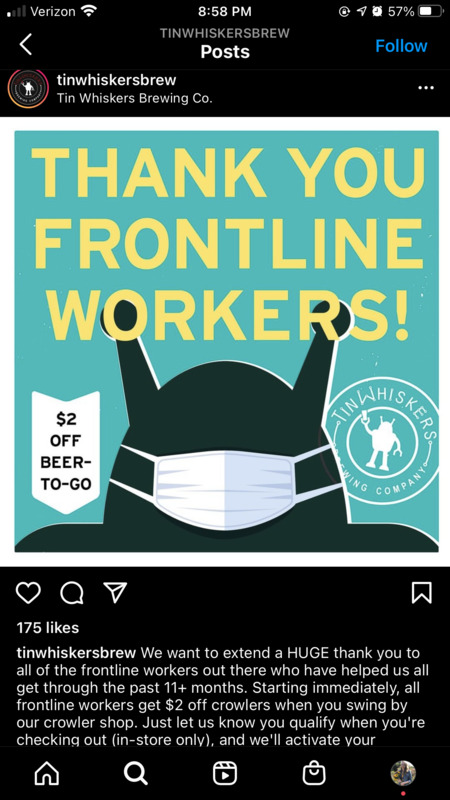
2021-02-03
To thank those risking their health for the benefit of others, Tin Whiskers Brewing Co. in Saint Paul, Minnesota showed their appreciation by offering a discount on take-out beer to frontline workers. They included health care workers, educators, first responders, service industry workers, postal workers, and public transit workers in their list, and were open to suggestions to add to that list. While a discount on beer doesn't make up for all the work these individuals do, it is a nice gesture to show appreciation during this challenging time. Given that those working in this brewery are also service industry workers, they recognize the risks and difficulties that frontline workers have been experiencing, and wanted to make it clear how much these people do for society.
Instagram caption: @tinwhiskersbrew
We want to extend a HUGE thank you to all of the frontline workers out there who have helped us all get through the past 11+ months. Starting immediately, all frontline workers get $2 off crowlers when you swing by our crowler shop. Just let us know you qualify when you're checking out (in-store only), and we'll activate your discount.
What constitutes a frontline worker?
--Health Care Workers
--Educators
--First Responders
--Grocery/Retail/Pharmacy/Liquor Store Employees
--Bar/Brewery/Restaurant Service Industry
--Postal Service/Delivery
--Public Transit Workers
If we missed a field, let us know! We definitely want to thank you too.
-
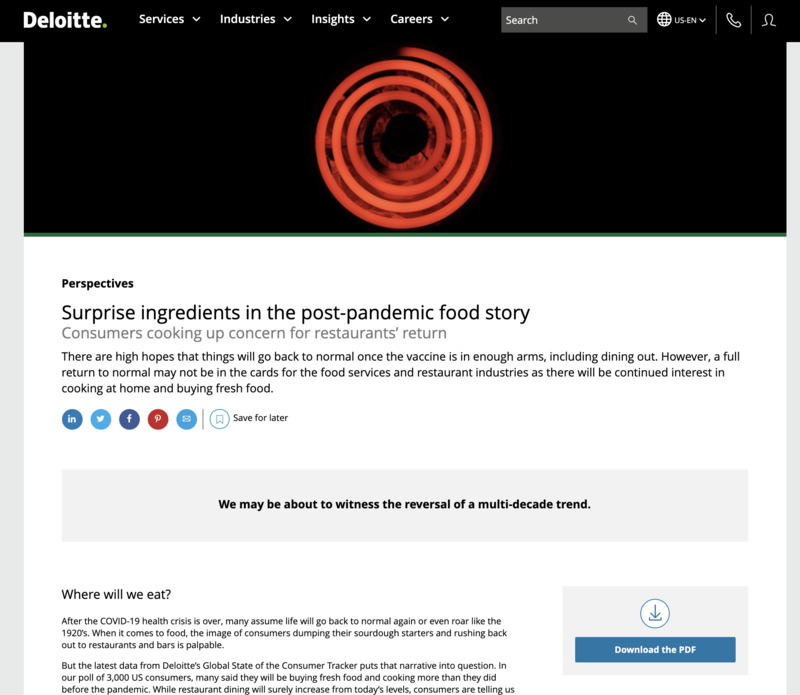
2021
Given the changes the food industry had to go through to adapt to the pandemic, it is unlikely all of those changes will go away as vaccination rates continue to rise and positive COVID-19 cases go down. With an increase in consumers enjoying fresh food and home cooked meals, there is a possibility this decrease in eating out will continue even as restrictions are lifted. This could be due to new social norms, saving money, or even newly developed preferences. Only time will tell if these patterns are predicting the future, or if they will change once more as public spaces become safe again.
-

2021-04-25
Going into this internship, I really didn’t know what to expect. Throughout undergrad, I worked full time jobs and did not have the time to take on any internships or research positions, so this was my first experience with it. I also was studying anthropology and was uncertain what path I wanted to take, making it hard to find internships that felt applicable to my future. Once I decided to study history with a goal of pursuing a public history career, this internship seemed like an incredible opportunity to learn more about the field and get a feel for what a possible future career could be. Thanks to the Public History Methodology course taught by Dr. Mark Tebeau, I did have a decent amount of knowledge of what public history consisted of, which made it clearer to me what I wanted to pursue and gave me an understanding on which I could build throughout this internship. Working with JOTPY provided hands-on experience in which I could apply this knowledge and learn the applicable skills necessary to practice public history. These skills included managing metadata, conducting and transcribing oral histories, marketing new collections, prioritizing the safety and privacy of contributors, learning to work with a team remotely, and acknowledging and confronting the silences present in the archive. As I continue to volunteer with JOTPY past the end of my internship, I hope to strengthen these skills, growing more comfortable with curating so that I may carry that with me once I move on from this archive.
Given that this was my first experience like this, much of the work I did was initially out of my comfort zone. The scope of this archive was a bit intimidating, and I did not initially understand how important and impactful JOTPY is and will continue to be, even past the pandemic. As the weeks went on, I grew more comfortable curating, as well as interacting with the team over Slack and Zoom, which I hadn’t utilized very much before this internship. I was also unfamiliar with marketing something like a collection, so having the opportunity to do so pushed me past my comfort zone and taught me how to better write for a public audience in a way that is both succinct and engaging. I learned that I really enjoy this type of work, particularly when it came to creating a collection, as it gave me the opportunity to address a silence and advocate for an underappreciated group of people while pulling from personal experience and situations that I have observed. My goal in life is to help people, and this was a great opportunity to help in a more subtle, behind-the-scenes sort of way. Since I had already hoped to pursue a career in the field of public history, specifically working with museums, this internship did not necessarily change my approach; however, it did strengthen my desire to work in this field, and taught me the necessary skills to feel confident that this is the right path for me.
-
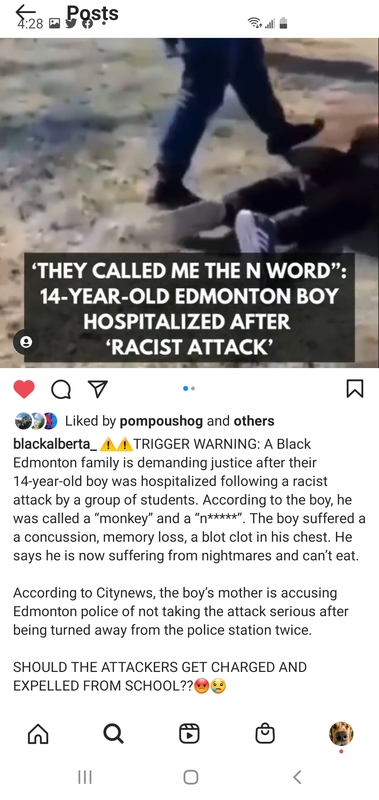
2021-04-24
On April 16th 2020, a 14 year old 8th grade student named Pazo was brutally attacked by seven white students. This attack was entirely racially motivated, they screamed slurs at him, beat him mercilessly, taunted him. They dragged him, choked him, and recorded their actions which they posted on social media. They attacked Pazo because of the colour of his skin, Pazo has stated after the attack that this assault has "made me afraid to wear my own skin." This is more than unacceptable, this is disgusting. As the post stated, these 'kids' gave Pazo a concussion, memory loss and a blood clot in his chest; he could of easily have been killed. What's worse, is there was no action taken by the school, which called this brutal hate crime a "altercation" by the school board. Ontop of this, the post states that the Edmonton Police also refused to investigate this assault, turning away the boy's family twice. This assault would of likely been swept under the rug if it were not for the pushback of the community, and the outrage generated by the presence of the video online. With the growing pressure from the public, the Edmonton police service are being demanded to investigate this assault, which again is only made possible through the pressure of the people. Furthermore, the lack of action and attempts to nullify the significance of this assault by the principal and the school board has resulted in students and teachers pushing for the forced resignation of those accountable, such as the principal and superintendent. Other social media platforms have stated that this is not the first time the principal of the school has played down similar incidents; which has left students feeling vulnerable. This cannot continue, these students must be held accountable - Albertans need to understand that white supremacism is a very real problem, and it is not going anywhere by ignoring it. As we have seen throughout the pandemic, events such as this are a rarity - we only know of the severity of the attack and the response of our education institutions because this attack was recorded and circulated online.
-
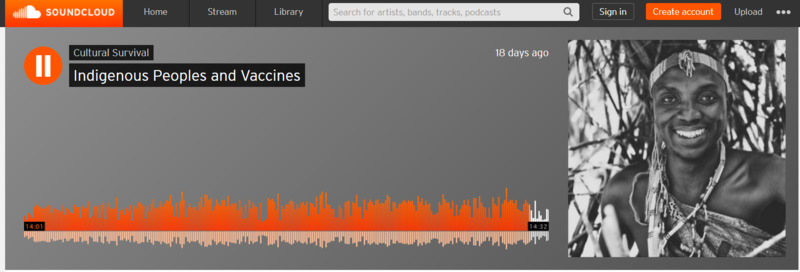
2021-04-07
“The coronavirus (COVID-19) pandemic poses a grave health threat to Indigenous peoples around the world. Indigenous communities already experience poor access to healthcare, significantly higher rates of communicable and non-communicable diseases, lack of access to essential services, sanitation, and other key preventive measures, such as clean water, soap, disinfectant, etc.”
-
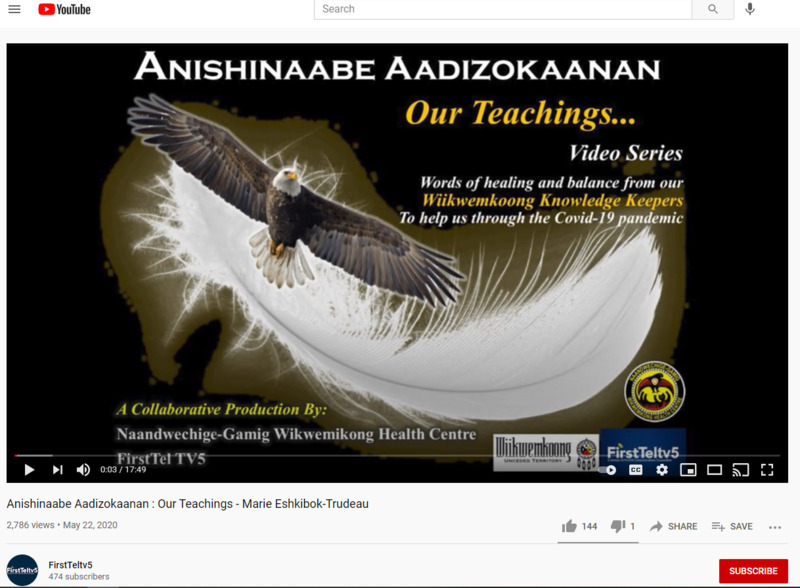
2020-05-22
In this video, Anishinaabe elder Marie Eshkibok-Trudeau shares the teachings she learned from her Elders. Eshkibok-Trudeau states that the COVID-19 virus is a strong negative spirit. It is vital to take care of your spirit and physical needs while connecting with the Earth. These practices will help combat any COVID-19 fears that try to take our minds.
-
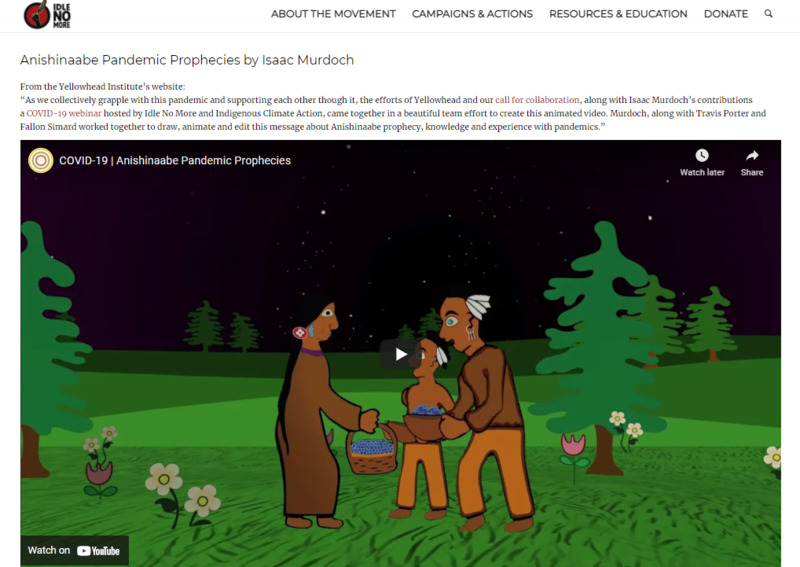
2020-05-19
From the Yellowhead Institute’s website:
“As we collectively grapple with this pandemic and supporting each other though it, the efforts of Yellowhead and our call for collaboration, along with Isaac Murdoch’s contributions a COVID-19 webinar hosted by Idle No More and Indigenous Climate Action, came together in a beautiful team effort to create this animated video. Murdoch, along with Travis Porter and Fallon Simard worked together to draw, animate and edit this message about Anishinaabe prophecy, knowledge and experience with pandemics.”
-
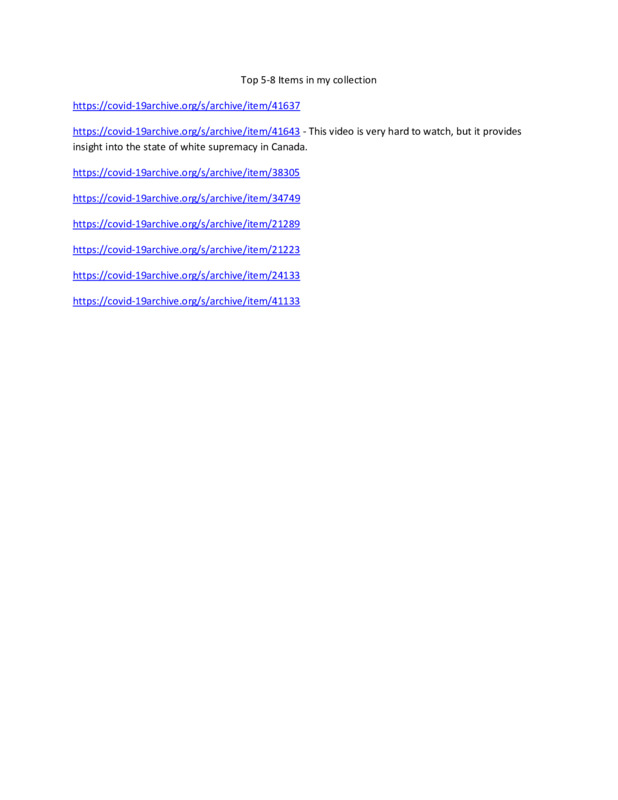
2021-04-25
This is my portfolio for my internship experience with the JOTPY, thank you so much for this; I really enjoyed working with each and every one of you - thank you for everything.
-
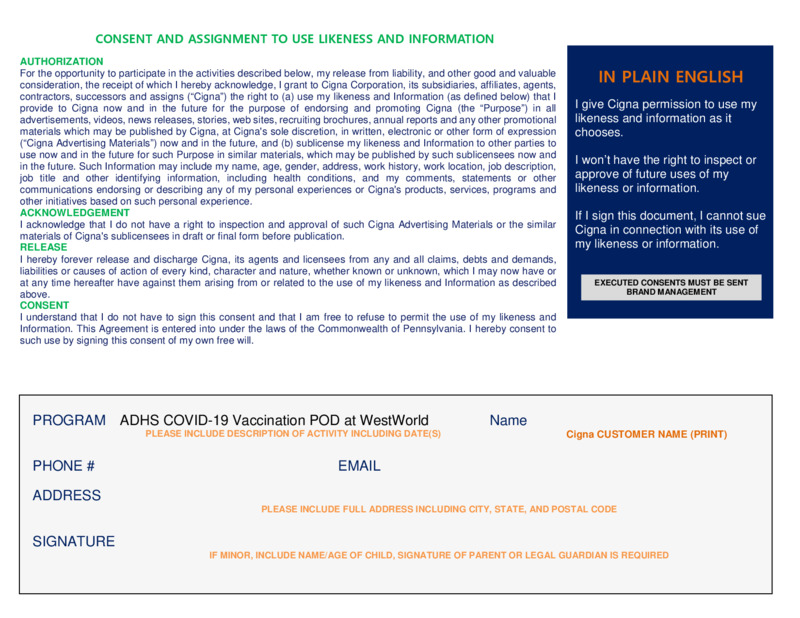
2021-04
I like to volunteer for good causes, and I though that volunteering for a Covet-19 and I thought that volunteer at one of the Vaccination Centers was one of them . . . until I read the fine print. Among the normal document you have to sign, the last one was title “Consent and Assignment to use Likeness and Information”.
The first part is just fine, of course if pictures are taken during your duty, you allow them to use it for promotion etc etc, but the second part is about “Information” and the text says:
“Such Information may include my name, age, gender, address, work history, work location, job description, job title and other identifying information, including health conditions, and my comments, statements or other communications endorsing or describing any of my personal experiences or Cigna's products, services, programs and other initiatives based on such personal experience”.
So, in order to volunteer for a good cause, I have to agree to release my personal info about my personal life and health condition?
I attached the all document, please read the full document before volunteering, you may volunteering too much.
-
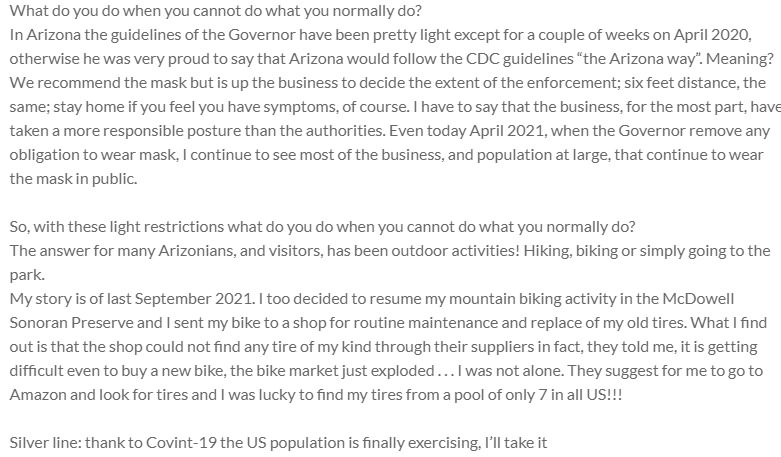
2020-09
What do you do when you cannot do what you normally do?
In Arizona the guidelines of the Governor have been pretty light except for a couple of weeks on April 2020, otherwise he was very proud to say that Arizona would follow the CDC guidelines “the Arizona way”. Meaning? We recommend the mask but is up the business to decide the extent of the enforcement; six feet distance, the same; stay home if you feel you have symptoms, of course. I have to say that the business, for the most part, have taken a more responsible posture than the authorities. Even today April 2021, when the Governor remove any obligation to wear mask, I continue to see most of the business, and population at large, that continue to wear the mask in public.
So, with these light restrictions what do you do when you cannot do what you normally do?
The answer for many Arizonians, and visitors, has been outdoor activities! Hiking, biking or simply going to the park.
My story is of last September 2021. I too decided to resume my mountain biking activity in the McDowell Sonoran Preserve and I sent my bike to a shop for routine maintenance and replace of my old tires. What I find out is that the shop could not find any tire of my kind through their suppliers in fact, they told me, it is getting difficult even to buy a new bike, the bike market just exploded . . . I was not alone. They suggest for me to go to Amazon and look for tires and I was lucky to find my tires from a pool of only 7 in all US!!!
Silver line: thank to Covint-19 the US population is finally exercising, I’ll take it
-
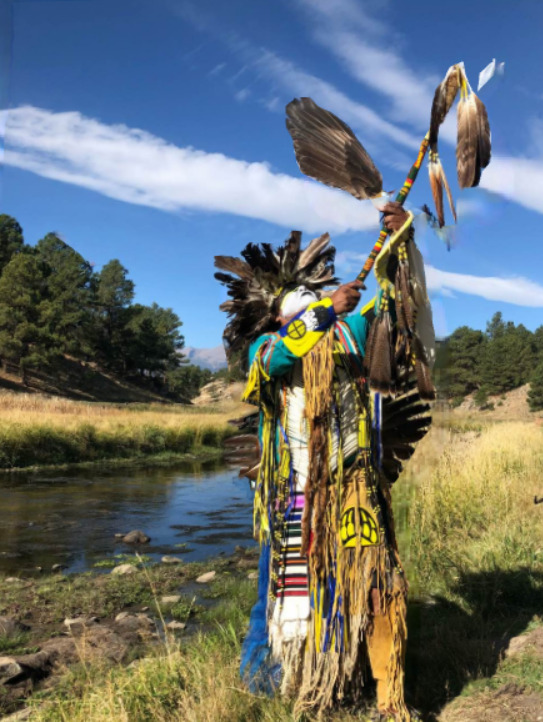
2021-04-25
For many reasons, The Journal of the Plague Year internship is the culmination of my graduate school experience. Other than my Public History Methodology course, my exposure to this field was quite limited. Now, this internship is prompting me to broaden my scope of professional interest and explore all that archival and preservation work has to offer. It is an exciting prospect that I look forward to pursuing soon.
There are so many aspects that I enjoyed during my time with JOTPY. Although the curation experience I gained and the people I met tie at a close second, my favorite experience was identifying silences within the archive. I had no idea that within a year of reading Marisa J. Fuentes’s, Dispossessed Lives: Enslaved Women, Violence, and the Archive, I would be identifying an Indigenous silence within the JOTPY archive. Creating the collection, Indigenous Point of View, to combat this silence was a unique experience that I will never forget. I gained invaluable experience writing its Call for Submissions and Indigenous POV Press Release while critically thinking how to build the collection. I learned so much about resilience within Indigenous culture throughout North America and look forward to other ways to assist in Indigenous land sovereignty efforts and the demarginalization of this beautiful culture.
As for other notable experiences, my time with JOTPY allowed me to practice thinking like a historian while curating, conducting oral histories, and co-creating a digital exhibit. Also, I was able to informally network with JOTPY leads during some of the weekly Town Hall meetings and observe planning sessions on marketing events such as the one-year anniversary of the archive. It was fascinating to participate in these conversations while getting to know JOTPY partners across the country. What an invaluable opportunity.
Thank you to Dr. Mark Tebeau, who quickly responded to my email expressing interest in the internship. Also, an enthusiastic thank you to Dr. Kole. Not knowing what to expect when I started with JOTPY, I wondered how much the interns would work together. However, her peer-review assignments and her encouragement for intern collaboration created many opportunities to connect. Her method of facilitation was succinct, fun, and fostered so much collaboration within my cohort.
Enduring the COVID-19 pandemic with fellow interns across North America made these first four months of 2021 so much more bearable. We shared a moment in history in a way that the majority of the world never will. I leave this unique internship with valuable new archival skills that I am confident will serve me well. I move forward with more historical tools in my toolbelt, new professional connections, and new friends. A great way to conclude indeed.
-

2021-04-25
Now that the CDC has cleared the J & J one shot and done again after the scare of blood clots people are ready to get their shots. Will people line up to get the J&J shot? I hope they will as there are lots of them in stock here.
-

2021-04-23
People in the LGBTQ community feel that the former Democratic Presential nominee is not out for their best interest but instead is just using them for their vote. They feel like he should push more for homelessness, housing, healthcare, and other issues important to the LGBTQ people but Mr. Yang says he loves and supports the community. He is running for New York City mayor and is the former nominee of the democratic party.
-

2021-04-07
A new law making its way through the North Carolina legislator would force educators to out Transgender students to their parents. It also would not allow for people younger than 21 to have hormones for transgender surgery or to have surgery or anything like that.
-
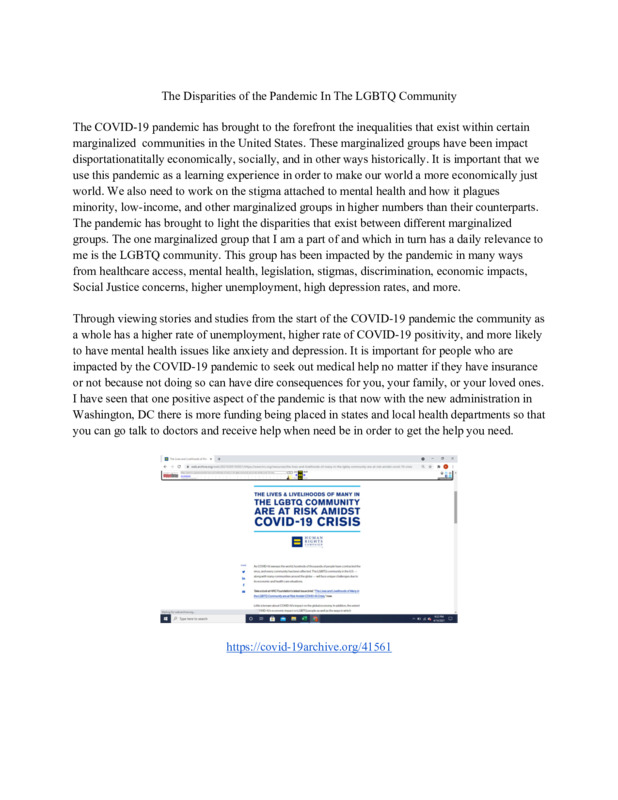
2021-04-25
The internship experience has been one that has taught me many new and different skills that I did not have before or were very low on my abilities prior to this experience. Before I started this internship I had no experience in the field of public history or curation. I gained skills like learning how to preserve various sources for future posterity. I learned the process of properly using a system like Omeka, securing digital sources for the future, working on collections, oral histories, and more. The oral history part of my internship gave me skills that I can bring into my current role as a Social Studies Curriculum Coordinator by having some of our teachers encourage our students to conduct oral histories of our local town members in order to meet their standards in our state. My school uses the hands-on teaching method in order to bring the curriculum alive and this could be one way to implement and bring history alive.
I also sharpened my skills of teamwork, collaboration, and virtual zooming in order to meet a project end goal. One thing this experience has taught me is that the pandemic has caused technology and collaboration to be taken to a next level and that I feel it will continue to grow and change in the future. This experience will also be memorable due to the fact that the actual documentation of the history is occurring while the events are happening not after the fact which is a unique experience.
-
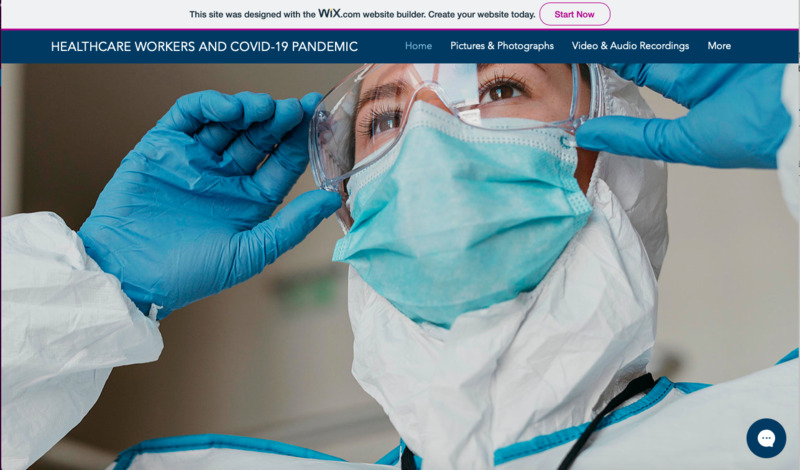
2021-03-29
The website designed was chosen to focus on the topic of healthcare workers and their role during the ongoing COVID-19 pandemic. It showcases multiple elements of media from pictures, videos, social media posts and other engagements that compile information and stories about frontline healthcare workers that are putting their lives on the line to save people. It is necessary that the general population has an understanding of what our healthcare workers are going through during such an unprecedented time. It was important for me to show this side of healthcare workers because they are the heroes amongst our society, and we all talk about fictional heroes or figures and whatnot, but we need to appreciate those that are fighting and sacrificing themselves, for the betterment of our health. This archive project was for university course that I took this semester, and it required extensive research, but additional to that I also had the opportunity to reach out to healthcare workers and get their stories, combined with the many stories that are shared online by them, and compiled, they have helped in constructing this body of a work which I was fortunate enough to create. A large gratitude to them because without our healthcare workers, there would be no health in our societies.
-
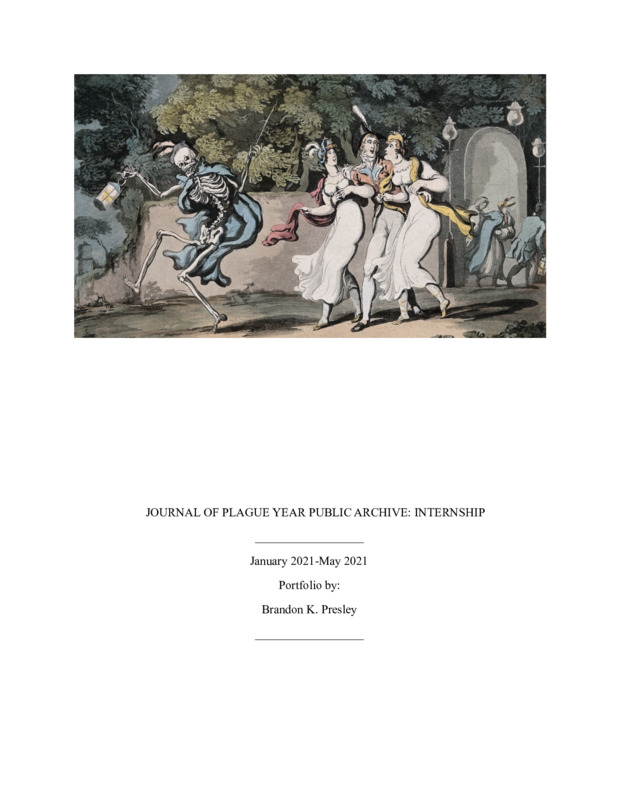
2021-04-24
This is my portfolio from my experience of working as an intern with the Journal of the Plague Year Public Archive.
-

2020-07-12
Tucson Medical Center went from no Covid patients in January 2020 to approx 160 at the peak (actually our third) in January 2021. It was amazing to see how quickly beds were repurposed, negative flow rooms were engineered, elective surgeries were cancelled and all the staff rallied around the ever changing patient case loads.
Paula Marshall, RN July 12, 2020 at TMC Bed Control Department
I work at Bed Control. We accepted patients from mostly southern Arizona from our ER and from the surrounding rural hospital. The Covid Surg line would call distributing covid patients needing admission throughout the area.
When I graduated from nursing school in 1974, I never guessed that our world would experience a pandemic in my lifetime. I never knew that my job would change the way my family viewed my job. I don’t work at the bedside but work in an office and contribute to bed utilization. My son’s family lives 6 miles from me but I was invited to visit 4 times during 2020. My granddaughter said, “you work in a hospital. You could have Covid and not know it.” Gee whiz
-
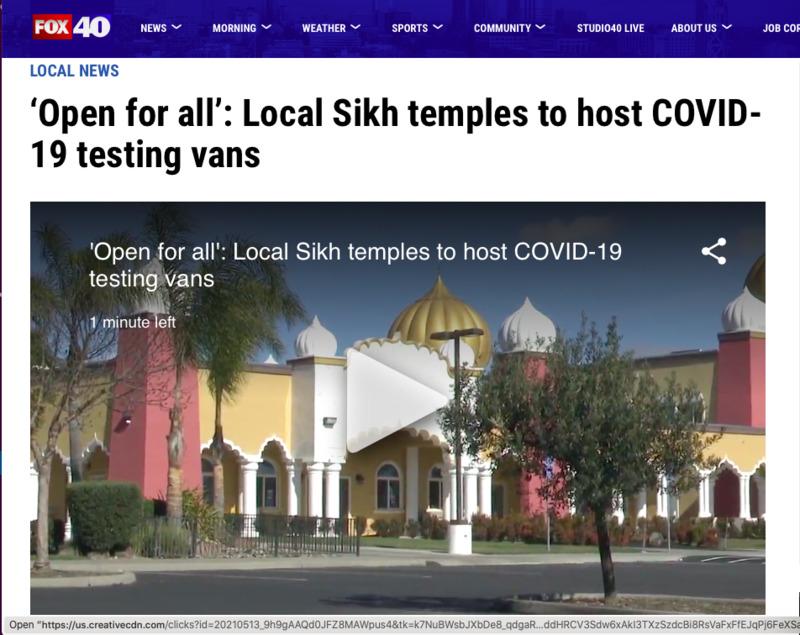
2021-02-12
The Sikh community has been working vigorously to help the communities they are in as much as possible. In San Joaquin County, Sikh temples have temporarily transformed their worship areas into massive COVID-19 testing sites. As the article notes, Sikhism “is based on giving back to the community and believing in community service.” Even though vaccination is continuing to roll out, the Sikh community is working to help drive down the positivity rate by getting as many people tested as they can.
-
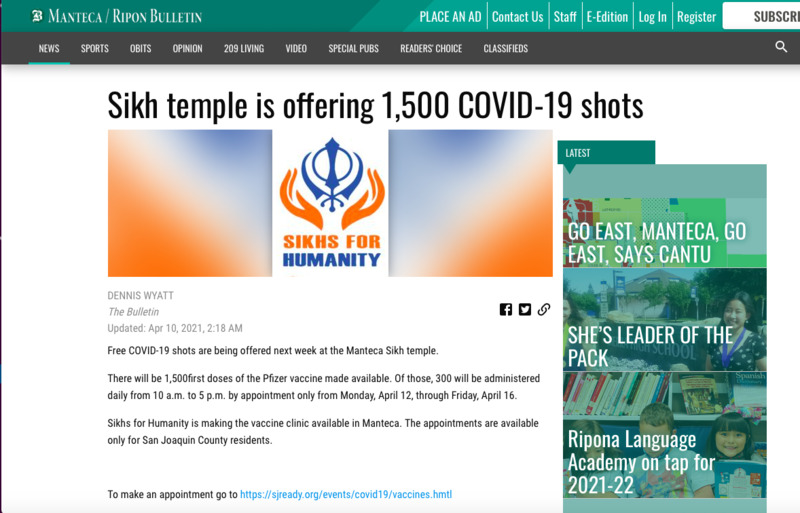
2021-04-10
For most religions, helping in the community is a necessity. For Sikhs, it is no different. This article details how a Sikh temple has allowed its building to be used for the distribution of 1500 COVID-19 vaccines. Throughout the history of Sikhism, a premium has been placed on service and charity. By providing its building for easy access to vaccines, this Sikh temple is playing its role to help get back to normalcy.
-
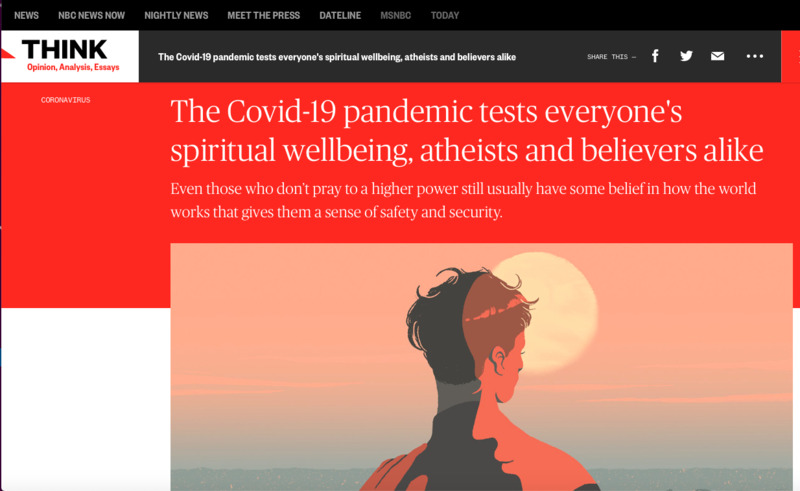
2020-09-21
When looking at the pandemic, regardless of one’s religious beliefs, or lack thereof, nearly everyone’s spiritual wellbeing has been tested. On one hand, spiritual struggle has been linked to higher mortality rates as well as depression. On the other, however, proper spiritual care has been shown to help people get through a rough time. Chaplains play a major role for those who are sick or injured. Simply because someone does not identify with organized religion does not mean they can be provided with spiritual care.
-
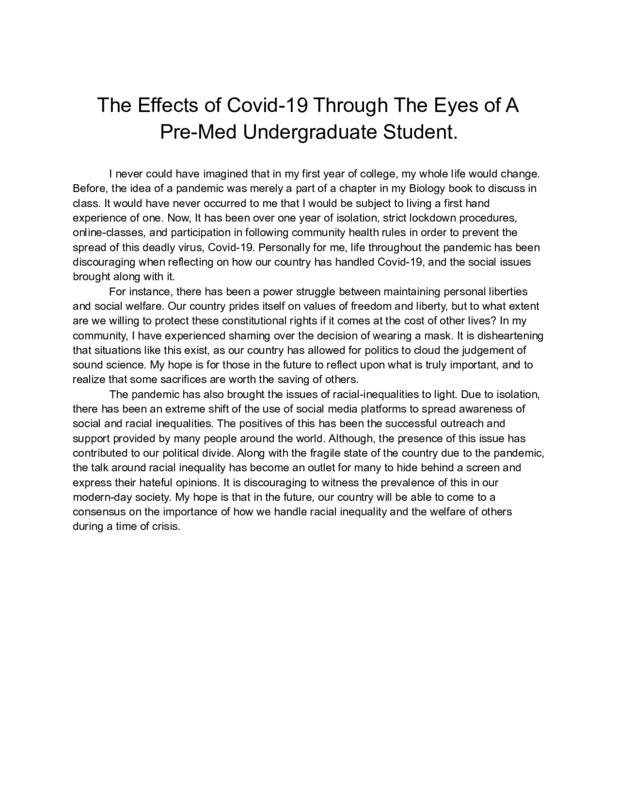
2021-04-23
My reflection is to bring awareness of the increasing divide of our country through the impact of a pandemic . This is important to me because I believe that it affects the way we approach and solve global issues. My hope is that this reflection will give insight of the major issues that have occurred throughout this pandemic, and inspire those in the future to create possible solutions.
-
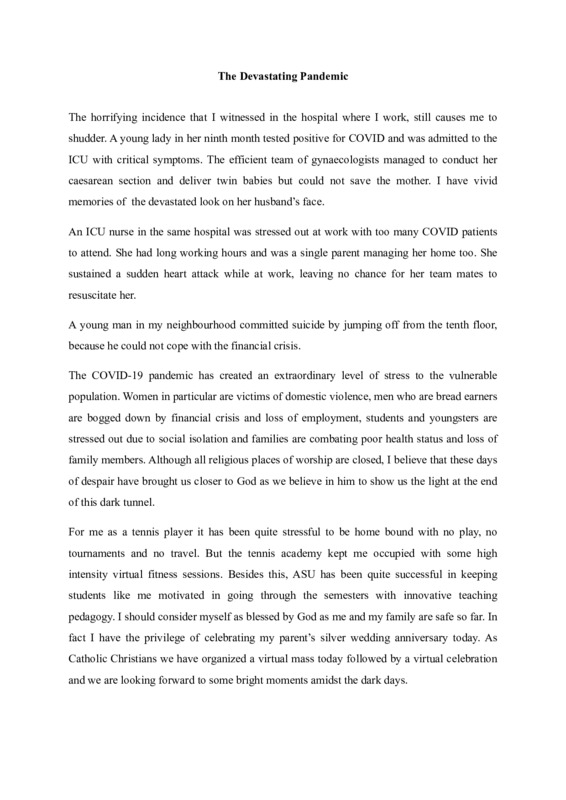
2021-04-24
I have been witness to some really traumatic life events. This has made me experience the pain and agony of individuals and their families during this pandemic. This has also made me grateful for keeping me and my family safe.
-
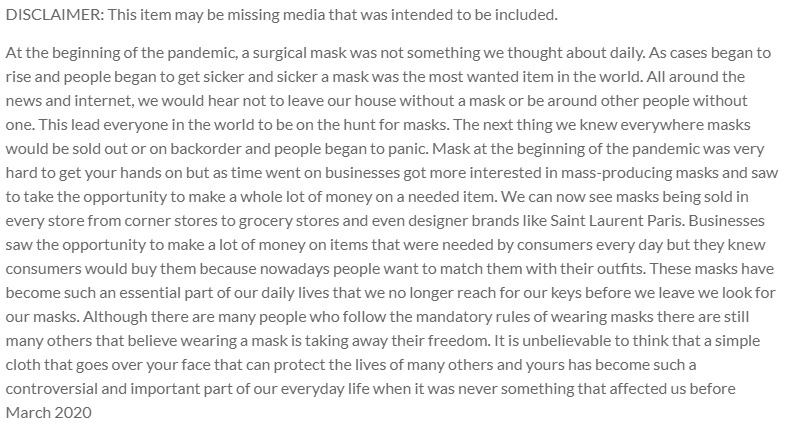
2021-04-23
At the beginning of the pandemic, a surgical mask was not something we thought about daily. As cases began to rise and people began to get sicker and sicker a mask was the most wanted item in the world. All around the news and internet, we would hear not to leave our house without a mask or be around other people without one. This lead everyone in the world to be on the hunt for masks. The next thing we knew everywhere masks would be sold out or on backorder and people began to panic. Mask at the beginning of the pandemic was very hard to get your hands on but as time went on businesses got more interested in mass-producing masks and saw to take the opportunity to make a whole lot of money on a needed item. We can now see masks being sold in every store from corner stores to grocery stores and even designer brands like Saint Laurent Paris. Businesses saw the opportunity to make a lot of money on items that were needed by consumers every day but they knew consumers would buy them because nowadays people want to match them with their outfits. These masks have become such an essential part of our daily lives that we no longer reach for our keys before we leave we look for our masks. Although there are many people who follow the mandatory rules of wearing masks there are still many others that believe wearing a mask is taking away their freedom. It is unbelievable to think that a simple cloth that goes over your face that can protect the lives of many others and yours has become such a controversial and important part of our everyday life when it was never something that affected us before March 2020
-
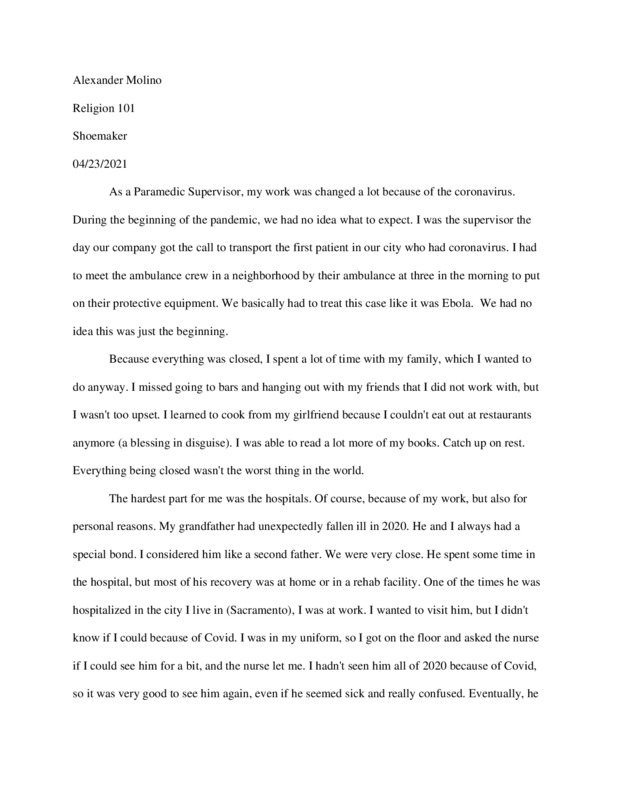
2021-04-23
How the pandemic effected me personally at home and at work
-
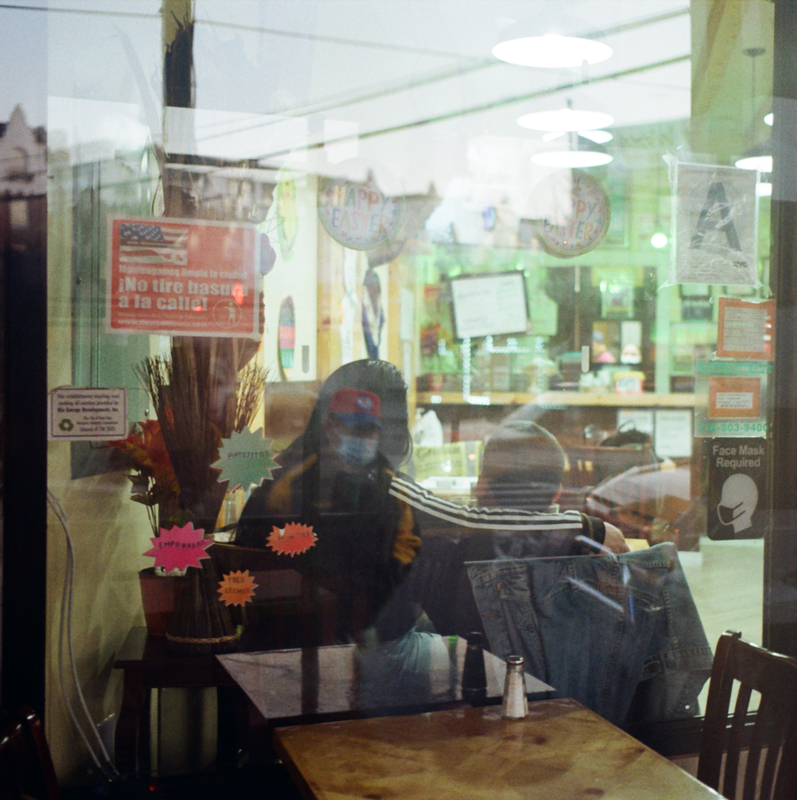
2021-03-15
Dear COVID,
You tried to break us. You were rampant. You were brutal. You did not discriminate. You were careless. You hit NYC hard, and didn’t stop. You stormed through our diverse neighborhoods. Our middle class and hard working people. Our less-fortunate. Our most vulnerable. Our elderly and incapable. We became the epicenter at one point, and it didn’t stop there. You halted our way of life. You shut down our small businesses. Our restaurants. Our bars. Our necessities and invaluable operations. Our transportation systems. You divided families and friends. You caused us to feel lonely and scared. Worried. You put people out of work. You ruined lives. You murdered many. But, we’re still here. And we aren’t going anywhere.
We fought back. We’re still fighting back. You haven’t gone anywhere, but we’ve learned to live with you. For now. We have regained some aspects of our way of life. We continue to support each other in times of need. We support our small businesses and give back to our communities. We are finding ways to comfort each other and be with one another again. We are being smart. We are being considerate to others and continue to do so. You may still be very present in our everyday lives, but not for long. We will come back from this, stronger than ever. Thank you for showing us what we are made of.
Sternly,
NYC
COVID has been tough on us in the States, more particularly in NYC. This virus is ruining many lives and is still very present. NYC has been affected in many ways, and still continues to be. This has something our city has never had to experience. Unfortunately, the process has been very slow. However, with vaccinations, and herd immunity, we shall get through this and bring back our city with a bang. My family and I have been very fortunate thus far and I always try my best to find ways to give back and support local businesses and families that have been hit hard. I believe everyone should do this to the best of their ability in a time like this. Through all this, we as a city is still standing strong and our will is not broken. The photo attached is a small glimpse of ways we are getting by while also be weary of our actions. You can see a couple enjoying their time at a restaurant, while in the reflection, a stranger wearing a mask and being mindful of other’s health.
-
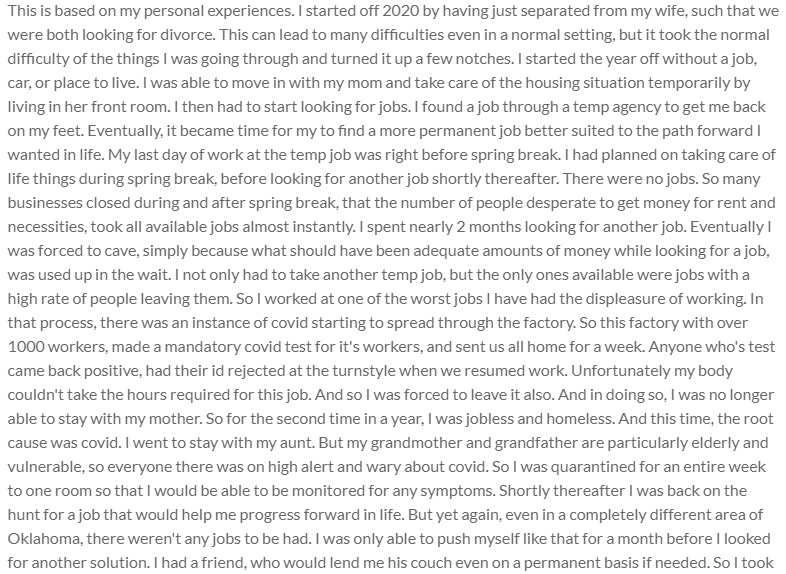
2021-04-23
This is based on my personal experiences. I started off 2020 by having just separated from my wife, such that we were both looking for divorce. This can lead to many difficulties even in a normal setting, but it took the normal difficulty of the things I was going through and turned it up a few notches. I started the year off without a job, car, or place to live. I was able to move in with my mom and take care of the housing situation temporarily by living in her front room. I then had to start looking for jobs. I found a job through a temp agency to get me back on my feet. Eventually, it became time for my to find a more permanent job better suited to the path forward I wanted in life. My last day of work at the temp job was right before spring break. I had planned on taking care of life things during spring break, before looking for another job shortly thereafter. There were no jobs. So many businesses closed during and after spring break, that the number of people desperate to get money for rent and necessities, took all available jobs almost instantly. I spent nearly 2 months looking for another job. Eventually I was forced to cave, simply because what should have been adequate amounts of money while looking for a job, was used up in the wait. I not only had to take another temp job, but the only ones available were jobs with a high rate of people leaving them. So I worked at one of the worst jobs I have had the displeasure of working. In that process, there was an instance of covid starting to spread through the factory. So this factory with over 1000 workers, made a mandatory covid test for it's workers, and sent us all home for a week. Anyone who's test came back positive, had their id rejected at the turnstyle when we resumed work. Unfortunately my body couldn't take the hours required for this job. And so I was forced to leave it also. And in doing so, I was no longer able to stay with my mother. So for the second time in a year, I was jobless and homeless. And this time, the root cause was covid. I went to stay with my aunt. But my grandmother and grandfather are particularly elderly and vulnerable, so everyone there was on high alert and wary about covid. So I was quarantined for an entire week to one room so that I would be able to be monitored for any symptoms. Shortly thereafter I was back on the hunt for a job that would help me progress forward in life. But yet again, even in a completely different area of Oklahoma, there weren't any jobs to be had. I was only able to push myself like that for a month before I looked for another solution. I had a friend, who would lend me his couch even on a permanent basis if needed. So I took him up on that offer. And I moved from Oklahoma to California. That drive was more or less the most impactful part of covid to me. I had seen the roads get empty on my way to/from work as people had stopped non-essential travel. But Oklahoma didn't have an enforced mask mandate. We could still go to the store, or pay for gas for our car, without being required to wear a mask. Many businesses still had indoor dining even. But in that trip, the realization of the impact of covid, hit me. It was at the only gas station for 20 miles in either direction in the mojave. I walked up to the door to go in and pay for gas. And for the first time that year, I saw a sign saying masks were required to enter. After that, every other location I stopped at was the same. There were no more places I could go without a mask. Covid, was having a real and significant impact on other things in the world than just jobs, and people's financial struggles. After having made it to California, in a particularly populated area with plenty of jobs, I was still unable to find a job for two months, simply because of how the rest of the year had gone for me. Simply by requiring a stable work history, I was no longer able to apply for most jobs. Finally I did get a job. I got one in the food industry. And the impact of covid hit hard there too. After having finished my training, and worked for about a week, the state mandate came that closed both our indoor dining. A month later, outdoor dining followed suit. We weren't allowed to take drinks back to add things we may have forgotten, and instead had to remake them entirely, because of covid safety precautions. I've had my temperature taken every single work day since I started, which was unheard of in times before covid. Twice, we've shut down the store because a partner tested positive for covid, and everyone that worked with them was placed in a mandatory two week quarantine. The impact is so strong, that the company is even providing 2 hours paid time for both doses of the vaccine, as incentive to get vaccinated. It's clear to see, covid has had an incredibly strong impact on life, and turned the difficulty level of many peoples lives up beyond manageable levels.
 2020-05-09
2020-05-09 2020-09-30
2020-09-30 2021-04-12
2021-04-12 2021-05-03
2021-05-03 2021-01-22
2021-01-22 2021-04-30
2021-04-30 2020-03-06
2020-03-06 2021-04-28
2021-04-28 2021-04-26
2021-04-26 2020-04-18
2020-04-18 2021-04-28
2021-04-28 2021-04
2021-04 2020-04-08
2020-04-08 2021-04-23
2021-04-23 2021-04-26
2021-04-26 2020-03-29
2020-03-29 2021-03-03
2021-03-03 2021-04-25
2021-04-25 2020-10-06
2020-10-06 2021-03-10
2021-03-10 2021-04-12
2021-04-12 2021-04-25
2021-04-25 2021-04-22
2021-04-22 2021-02-03
2021-02-03 2021
2021 2021-04-25
2021-04-25 2021-04-24
2021-04-24 2021-04-07
2021-04-07 2020-05-22
2020-05-22 2020-05-19
2020-05-19 2021-04-25
2021-04-25 2021-04
2021-04 2020-09
2020-09 2021-04-25
2021-04-25 2021-04-25
2021-04-25 2021-04-23
2021-04-23 2021-04-07
2021-04-07 2021-04-25
2021-04-25 2021-03-29
2021-03-29 2021-04-24
2021-04-24 2020-07-12
2020-07-12 2021-02-12
2021-02-12 2021-04-10
2021-04-10 2020-09-21
2020-09-21 2021-04-23
2021-04-23 2021-04-24
2021-04-24 2021-04-23
2021-04-23 2021-04-23
2021-04-23 2021-03-15
2021-03-15 2021-04-23
2021-04-23